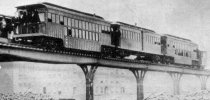There could be certain benefits in driverless - look at the DLR, and the Farringdon (Thameslink) tunnel, anything that helps achieve more dense track occupation will go some way to relieve overcrowding on the London commuter lines, and we have to remember that daily commuting now reaches out to places that are 90 minutes or more rail journey from the London termini. You couldn't get a seat at Guildford in the morning rush hour before the pandemic



(and the answer isn't simply more trains -track density is almost at saturation point).
However, what mitigates against that is the complexity of the network, especially around London with, arguably, the South East quadrant being the worst. The sheer number of junctions, crossovers etc would make a conversion to driverless almost impossible, with the potential that on top of the £7b price tag, you would then possibly have the years of delay before it works, as it could so easily become something along the lines of Crossrail or Berlin's airport in IT terms.
The compromise will probably have to be a major re-signalling that will allow shorter signalling blocks, and closer running of trains, but only after they've addressed the station infrastructure issues to get passengers off the platforms and out of the turnstiles quicker





